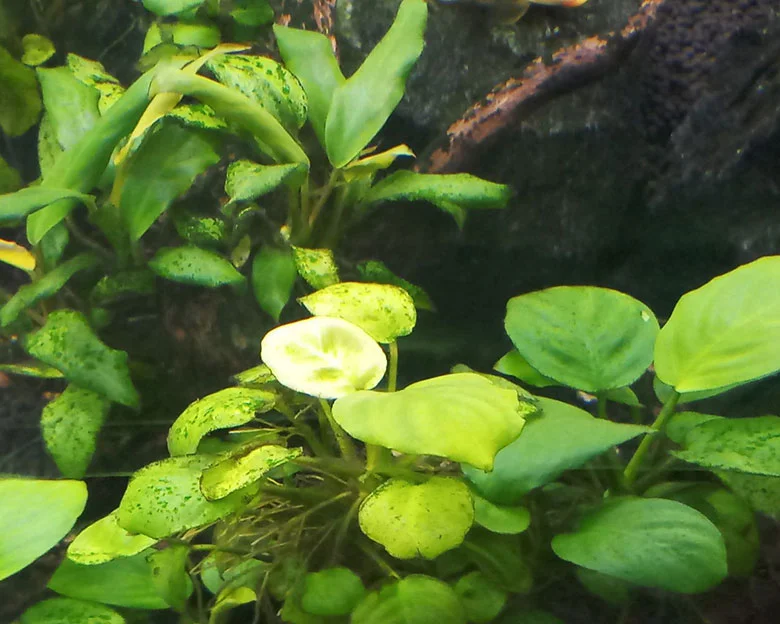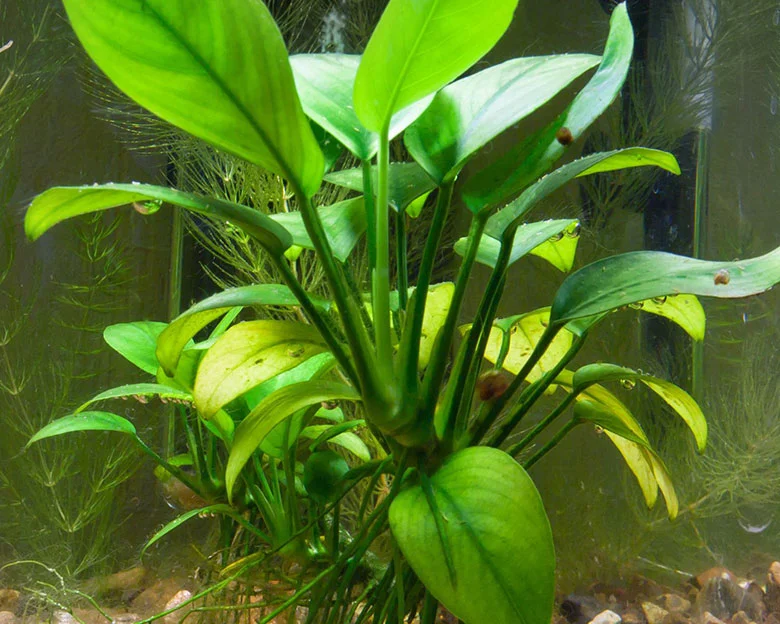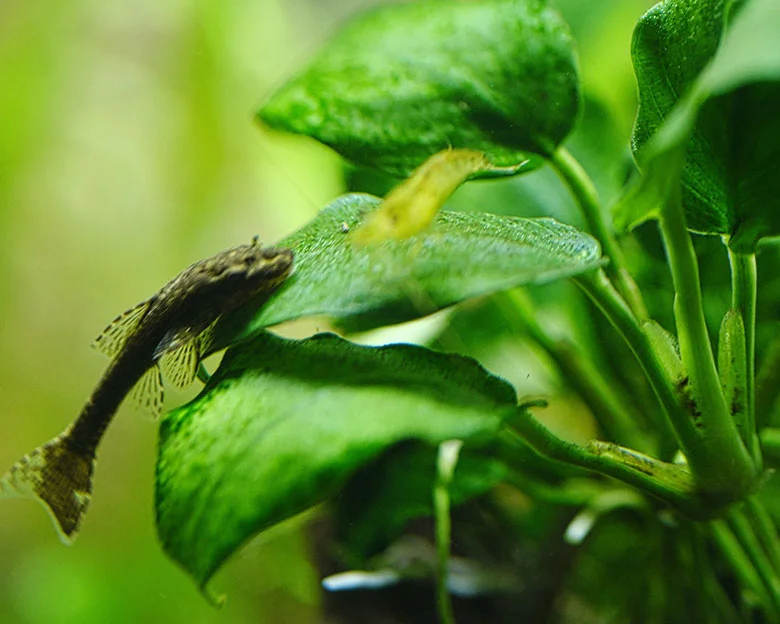Are you an aquarium aficionado searching for the perfect plant to enhance the beauty of your underwater world? Look no further than Anubias, the splendid selection that will surely satisfy your aquatic appetite.
Alluring, adaptable, and abundant, Anubias plants are an absolute asset for any aquarium enthusiast. With a plethora of types to choose from, such as Anubias Barteri and Anubias Barteri var Nana, these plants offer a unique blend of aesthetics and ease of care.
The key to their success lies in their low maintenance requirements, making them an ideal choice for both novice and experienced aquarists. Whether you’re a fan of thick, round leaves or prefer the charm of miniature varieties, Anubias has it all.
Join us as we dive into the depths of this aquatic wonderland, exploring propagation techniques, selecting healthy specimens, and uncovering the secrets of controlling algae growth.
So, strap on your scuba gear and get ready to embark on a captivating journey through the enchanting realm of Anubias plants.
Key Takeaways
- Anubias plants are popular freshwater plants for aquariums.
- There are numerous varieties of Anubias plants, each with unique characteristics.
- Anubias plants are low-maintenance and have a slow growth rate.
- Anubias plants require low to medium lighting and a nutrient-rich substrate.
Types of Anubias

If you’re looking to learn about the different types of Anubias plants, you’ll find that there are several varieties with unique characteristics and growth patterns. Anubias plants have a slow growth rate, which makes them perfect for aquariums. They require low to medium lighting, making them suitable for tanks with less intense lighting setups.
One popular variety is Anubias Barteri, known for its thick, round leaves. Another variety is Anubias Barteri var Nana, which is a miniature version that only grows to about 4 inches.
Anubias Barteri var Glabra has long-stalked, shield-shaped leaves and is hardy. Anubias Barteri var Caladiifolia has lush dark green leaves and can survive both underwater and out of water.
Each variety offers a unique look and growth habit, allowing aquarists to choose the perfect Anubias plant for their aquarium.
Plant Care and Maintenance
To keep your aquatic greenery thriving, make sure you provide regular care and maintenance. Anubias plants have specific lighting requirements to ensure their optimal growth. They require low to medium lighting levels, as excessive light exposure can encourage algae growth. It is important to plant Anubias in shaded corners of the tank to prevent algae growth.
Additionally, providing a nutrient-rich substrate is crucial for the health of these plants. Anubias plants can absorb nutrients from the water column or their surroundings, but planting them in a nutrient-rich substrate aids in their growth. This substrate should contain essential nutrients such as nitrogen, phosphorus, and potassium.
By meeting the lighting requirements and providing a nutrient-rich substrate, you can ensure that your Anubias plants thrive and add beauty to your aquarium.
Propagating Anubias
When propagating Anubias, you can start by sterilizing your tools and removing the plant from the tank. This process ensures a healthy and successful propagation.
There are several benefits of propagating Anubias. First, it allows you to expand your plant collection without having to purchase new plants. Second, it helps rejuvenate older or damaged plants by promoting new growth.
To ensure successful Anubias propagation, follow these tips. Begin by separating the roots and cutting the rhizome into multiple parts. Each new piece should be replanted in different parts of the tank to allow for proper growth. It’s important to provide a nutrient-rich substrate and maintain low to medium lighting for optimal growth.
Additionally, avoid damaging the rhizome during handling and ensure that each new plant has a healthy root system. By following these steps, you can enjoy the benefits of propagating Anubias and create a thriving aquarium.
Choosing Healthy Anubias
When choosing a healthy Anubias plant, look for firm, glossy leaves that are free of any yellowing or brown spots, as well as a root system with fibrous white roots that indicate good health. It is important to consider several factors that can affect the health of an Anubias plant in your aquarium.
One common mistake in Anubias care is excessive lighting, which can encourage algae growth and damage the plant. It is best to place Anubias plants in shaded corners of the tank to prevent this. Another mistake is not controlling algae growth, which can compete with the Anubias for nutrients.
Regularly removing existing algae using a toothbrush or algae magnet is essential. Additionally, some fish species can be destructive to Anubias plants, so it is important to research and choose compatible tankmates. By avoiding these common mistakes and ensuring ideal conditions, you can enjoy healthy and thriving Anubias plants in your aquarium.
| Factors Affecting Anubias Health | Common Mistakes in Anubias Care |
|---|---|
| Excessive lighting | Not controlling algae growth |
| Destructive fish species |
Positioning in the Aquarium

Positioning your Anubias plants strategically in the aquarium can enhance the overall aesthetic appeal and create a natural and balanced environment for your fish.
Here are some creative placement ideas for your Anubias plants:
- Create a stunning focal point by placing a larger species, such as Anubias gigantea, in the center of the tank. Its huge, dark, leathery leaves will command attention.
- Add visual interest by attaching Anubias Barteri var Nana Bonsai to driftwood or rocks. The clustered leaves resembling tiny trees will create a captivating scene.
- For a lush and green backdrop, plant Anubias Barteri var Caladiifolia in the shaded corners of the aquarium. Its lush dark green leaves will create a beautiful contrast.
- To create a natural-looking aquascape, place Anubias Barteri var Angustifolia in the foreground. Its low-maintenance spade-shaped leaves will add depth and texture.
- Ensure the best lighting conditions for anubias growth by placing them in shaded areas of the tank. Direct exposure to excessive light can encourage algae growth and damage the plants.
By carefully considering the placement of your Anubias plants, you can create a visually appealing and harmonious aquatic environment for your fish.
Anubias’ Resilience to Imbalances
Take advantage of Anubias’ resilience to imbalances by incorporating this plant into your aquarium setup. Anubias is known for its adaptability and can tolerate a wide range of water parameters, making it an ideal choice for both beginner and experienced aquarium owners.
Whether your tank has fluctuating pH levels or varying levels of nutrients, Anubias can thrive in these conditions. It can handle imbalances and stress, making it a hardy and reliable addition to any aquarium.
To showcase the impressive adaptability of Anubias, take a look at the table below:
| Water Parameter | Tolerance Level |
|---|---|
| pH | 6.0-7.5 |
| Temperature | 72-82°F |
| Lighting | Low to medium |
| Nutrient levels | Moderate |
| Water hardness | Soft to medium |
As you can see, Anubias can tolerate a wide range of water parameters, making it a versatile and forgiving plant for your aquarium.
Avoiding Damage from Fish

Now that you understand how resilient Anubias plants are to imbalances, let’s discuss how to avoid damage from fish in your aquarium. It’s important to choose fish that are compatible with Anubias plants to ensure their well-being. Here are some tips:
- Select fish that are known to be fish-friendly tankmates for Anubias plants.
- Avoid fish species that are known to be aggressive or have a tendency to nip at plants.
- Monitor and maintain the water parameters in your tank to create a healthy environment for both the fish and the plants.
- Keep an eye out for any signs of stress or damage to the Anubias plants, such as torn leaves or uprooting.
- If necessary, provide additional protection for the plants by creating barriers or using plant-safe products.
By following these guidelines, you can create a harmonious and thriving ecosystem in your aquarium, where both the fish and the Anubias plants can flourish.
Personal Experiences and Tips
Share your personal experiences and tips on caring for Anubias plants in your aquarium to help others create a thriving ecosystem. Anubias plants are known for their low maintenance and aesthetic appeal, but every aquarium is unique, and it’s always helpful to hear from fellow hobbyists.
One common issue that some aquarists face with Anubias plants is algae growth. If you notice excessive algae on your Anubias leaves, you can carefully remove it using a toothbrush or an algae magnet.
Another tip is to avoid introducing destructive fish species that may harm the plants. It’s also important to provide adequate lighting and a nutrient-rich substrate for optimal growth.
By sharing your personal experiences and troubleshooting tips, you can assist others in successfully caring for their Anubias plants and creating a beautiful, healthy aquarium environment.
Controlling Algae Growth
To control algae growth in your tank, make sure you provide the appropriate lighting conditions and maintain a nutrient balance in the water. Anubias plants thrive in low to medium lighting, so it’s important to avoid excessive light exposure. Placing the plants in shaded corners of the tank can help prevent algae growth.
Additionally, it’s crucial to have a nutrient-rich substrate for the plants to absorb nutrients from. This aids in their growth and helps maintain a healthy balance in the tank. It’s also important to control algae by regularly removing any existing algae on the plants. You can use a toothbrush or an algae magnet to gently scrub off the algae.
By following these practices, you can effectively prevent algae growth and keep your tank clean and healthy.
Anubias’ Contribution to Tank Upkeep
Take a moment to appreciate the superhero of your aquarium – Anubias plants, the ultimate guardians against algae and tank maintenance! The benefits of having Anubias in your aquascape are numerous.
First and foremost, these plants are excellent at controlling algae growth. They absorb excess nutrients from the water column, depriving algae of its food source. Additionally, Anubias plants have thick, glossy leaves that provide shade and create a natural barrier against algae. They also help maintain water quality by absorbing nitrates and other harmful substances.
Anubias plants are not only functional but also add beauty to your aquascaping designs. Their vibrant green leaves and various shapes and sizes make them a versatile and attractive addition to any aquarium.
So sit back and let Anubias take care of your tank, while you enjoy a clean and visually stunning underwater world.
Unlock the Benefits of Anubias Plants: Transform Your Aquarium Today!
Sit back and appreciate how Anubias plants effortlessly maintain your aquarium, providing a clean and visually stunning underwater world. These remarkable plants offer several advantages for aquarium owners. Here are three reasons why Anubias plants are the perfect choice for your tank:
- Low Maintenance: Anubias plants are known for their easy care requirements. They have a slow growth rate, which means they don’t need frequent trimming or pruning. Additionally, they can tolerate a wide range of water conditions, making them resilient and adaptable.
- Aesthetic Appeal: With their glossy green leaves and unique leaf shapes, Anubias plants add beauty and texture to any aquarium. Whether you prefer the compact Anubias Barteri var Nana or the striking Anubias Coffeefolia, there is a variety to suit every tank setup.
- Tank Upkeep: Anubias plants help maintain a healthy aquarium ecosystem. They absorb nutrients from the water column, reducing the risk of algae overgrowth. Furthermore, their dense foliage provides hiding spots for fish, promoting a natural and stress-free environment.
Consider incorporating Anubias plants into your aquarium setup to enjoy their numerous benefits. Happy fishkeeping!
Frequently Asked Questions
Are Anubias Plants Suitable For Saltwater Aquariums?
No, Anubias plants aren’t suitable for saltwater aquariums. They’re freshwater plants that thrive in low to medium lighting and require a nutrient-rich substrate. Anubias plants have a slow growth rate, making them ideal for planted freshwater tanks. While they’re excellent choices for freshwater aquariums, they aren’t compatible with saltwater environments due to their specific care requirements and inability to tolerate high salinity levels.
Can Anubias Plants Survive In Low-Light Conditions?
Anubias plants can survive in low-light conditions, making them a great choice for shaded areas in your aquarium. These plants have a slow growth rate and require low to medium lighting. Placing Anubias plants in shaded corners of the tank helps prevent algae growth, which can be controlled by avoiding excessive light exposure.
Their glossy green leaves not only add beauty to your tank but also aid in algae control. So, rest assured, Anubias plants will thrive in low-light conditions while keeping your aquarium clean and healthy.
How Often Should Anubias Plants Be Fertilized?
Anubias plants are truly resilient and require minimal care, but when it comes to fertilization, they aren’t demanding at all. In fact, these hardy plants can thrive without regular fertilization. Their slow growth rate means they don’t need frequent nutrient supplementation.
However, if you want to give them a little boost, you can fertilize them once every few months with a liquid fertilizer specifically designed for aquarium plants. It’s important to note that over-fertilization can lead to algae growth, so it’s best to err on the side of caution and provide only minimal fertilization.
Do Anubias Plants Require Co2 Supplementation?
Anubias plants don’t require CO2 supplementation for their growth requirements. They are known to thrive in low to medium lighting conditions and can absorb nutrients from the water column or substrate.
While CO2 supplementation can enhance the growth of certain plants, Anubias plants can grow well without it. However, it’s essential to provide a nutrient-rich substrate and control algae growth to ensure the healthy development of Anubias plants in your aquarium.
Can Anubias Plants Be Grown Emersed (Out Of Water)?
Yes, Anubias plants can be grown emersed, or out of water. This cultivation method has several benefits. Emersed growth allows the plants to develop stronger and more extensive root systems, which in turn leads to healthier and faster growth when they’re eventually submerged. Additionally, growing Anubias emersed can help control algae growth in the aquarium.
To successfully grow Anubias emersed, it’s important to use the right substrate. Some of the best substrates for growing emersed include a mix of potting soil and sand, or a specialized aquatic plant substrate.

